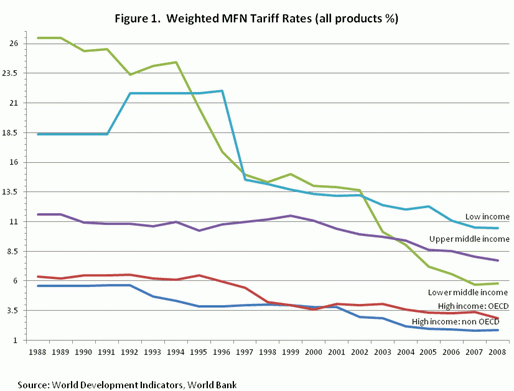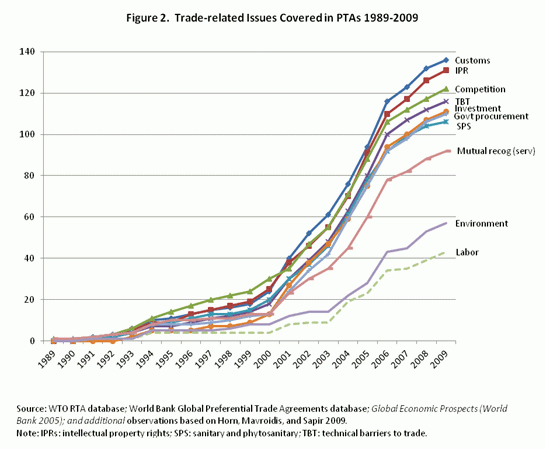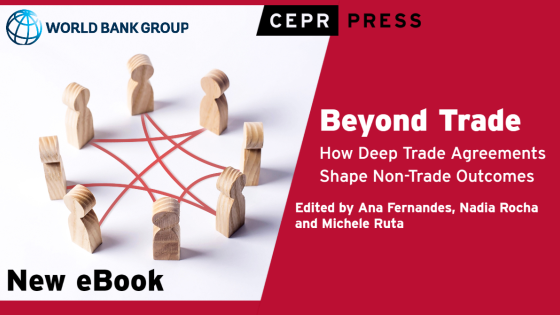The heartbeat of the Doha multilateral negotiations is flat-lining. Negotiators have so far even failed to agree on a minimal package for developing countries, and nobody seems to really care.
Trade liberalisation is popular, just not in Geneva
This despair-en-masse is, manifestly, not about the merits of free trade. While negotiators in Geneva have missed deadlines after deadlines, tariff rates have continued to decrease in all country groups (Figure 1).
Furthermore, despite mounting pressures from various lobbying quarters, countries have by and large refrained from using protectionist measures to mitigate the consequences of the 2008 global financial crisis even though the protectionist threat is still there (Evenett 2011). Trade is effectively freer today than it was a decade ago.
Figure 1. Weighted MFN tariff rates (all products)
At the same time as the reduction in tariffs, we have also witnessed a frantic pursuit of preferential trade agreements (PTAs) in the decade since the Doha negotiations were launched; a fact that is acknowledged by the release of the latest WTO World Trade Report (WTO 2011). All 153 WTO members but one (Mongolia) belong to at least one PTA and the average member belongs to 13 such agreements. And the pace does not seem to be losing momentum.
Yet, the proliferation of PTAs in an environment characterised by lower tariff protection has raised the issue of the rationale behind the pursuit of such agreements. Because more and more countries have access to similar preferences under various bilateral or regional arrangements, the actual significance of these preferences is actually rapidly eroding (Fugazza and Nicita 2010). So, if preferential market access is less likely to be an incentive, what are the motives behind the continued rise of PTAs?
The simple answer is that focusing just on tariffs is missing a lot of the action that takes place in preferential agreements. To be sure, tariffs and rules of origin are still a major problem in numerous PTAs, and so are tariff peaks in certain sectors (agriculture and textile in particular) or among countries that have still relatively high protection (middle income countries and some least developed countries). But increasingly the action in PTAs centres on the trade rules and the discipline of trade-related behind-the-border issues. For instance, in response to the Arab Spring, the EU has announced a partnership for democracy and shared prosperity going far beyond market access to further deepen integration with countries in the Southern Mediterranean, including through deep and comprehensive free-trade agreements. On the US side, once Congress passes the Korea, Colombia, and Panama free-trade agreements, the Trans-Pacific Partnership Agreement (TPP) – a deep free trade agreement being negotiated by the US and eight other Pacific countries – will become the single most important US trade initiative over the next several years (Barfield 2011).
The new opportunities created by preferential trade agreements
As documented in a new World Bank Handbook on Preferential Trade Agreement Policies for Development (Chauffour and Maur 2011), the reality of preferential integration is increasingly moving to a whole new set of trade-related policies that policymakers and economic actors must optimise for their own benefits (see Rocha and Teh 2011 and also Figure 2). For instance:
- The facilitation of trade transactions through the easing of border regulations is becoming a crucial agenda in a world where production processes are becoming deeply intertwined and where firm competitiveness is increasingly conditioned on rapid and seamless supply chains;
- While market access remains an important consideration in addressing domestic regulations that may unduly raise the costs of foreign competitors (such as product standards and services regulations), many other behind-the-border policies are becoming important to maximise the benefits of more open markets. Without sound investment protection, competition rules, or procurement practices, the potential gains from increased market access often remain unrealised;
- Furthermore, developed country technical standards (such as for food security, product standards, or intellectual property protection) as well as value-related standards (such as for labour and environmental norms) constitute a growing agenda in the PTAs involving developed countries, including in their relations with developing countries;
- Finally, the search for more efficient regulations and the promotion of regional public goods often require solutions beyond the frontiers of individual countries. This is all the more true for vulnerable developing countries in their quest for more resilient economic growth.
Figure 2. Trade-related issues covered in PTAs, 1989-2009
While some of these challenges could ideally be met at the multilateral level in the context of the WTO, or simply autonomously by countries on their own, the reality seems that many policymakers view PTAs as the Swiss Army knife for addressing a number of behind-the-border issues. While political-economy considerations often dictate the decision to enter into a trade agreement with a given partner or group of partners, it is also the case that the versatility and flexibility offered by PTAs are attractive in their own right to promote reforms by locking-in policies, encouraging best practices, and more broadly improving policy coordination among trading partners. In short, PTAs could be better suited than other instrument of liberalisation to handle the next frontier of trade openness, i.e. the increasingly important border and behind-the-border regulatory reforms agenda.
This is best illustrated by the liberalisation of trade in services, which has clearly become a big ticket item given the large and growing weight of services in the global economy, their strategic importance into most economic processes, and their key role in determining a country’s competitiveness. Regulation in services is pervasive and opening-up services is no easy task, as many service sectors cannot be simply liberalised through full deregulation. Most services sectors need to be regulated and defining the optimal level of regulation, including at the domestic, bilateral, or multilateral level is non-trivial. To be sure, multilateral negotiations on services trade have demonstrated their limits because they have tended to focus on market access, with little attention to domestic regulations, and because governments and private sectors have shown little drive for a new and ambitious multilateral agreement (Hoekman and Mattoo 2010).
In that respect, while PTAs have typically not fared better than multilateral negotiations often merely replicating the level of WTO commitments, a growing number of PTAs have undoubtedly expanded on what is available at the WTO and, in the process, have opened significant opportunities to address regulatory issues, including:
- the possibility to innovate and test on modalities of liberalisation as compared to the WTO to achieve more ambitious results, including the scope of liberalisation
- the absence of trade diversion effects in services trade preferential liberalisation – because of the de-facto multilateral, non-discriminatory nature of regulatory reforms
- the capacity to go beyond market access liberalisation and promote regulatory cooperation
These opportunities also hold for other regulatory areas where either market access is not necessarily the main issue (that is when the appropriate level of regulation matters as much) or in some cases hardly at all (as for the provisions dealing with the environment, labour conditions, or human rights).
The role of PTAs as tools for economic cooperation and dialogue in addition to market access may be another reason behind their recent success. Because PTAs are flexible and largely ad hoc they can serve as a space for mutually beneficial institutional arrangements. For example, they could rely on “soft law” types of arrangement, where best endeavours, consultations and dialogue, and progressive convergence lead to actual changes and become an alternative to formal dispute settlements. Another example is how PTAs rules and institutions can support the quest for regional public goods such as the establishment of common regulatory agencies or joint infrastructure projects.
The limits of PTAs
We should, however, guard against an angelic vision of preferential agreements. Following the trend of signing PTAs like the pied piper of Hamelin is unlikely to be productive. Unlike Swiss Army knives, PTAs are far from being simple to use and now cover complex and diverse areas of regulation. The law of unintended consequences may come back to haunt signatories when they have committed to rules that they did not fully comprehend or that they did not really need. PTAs are also only as good as their implementation is. Little is known about the day after and what follows the signature of agreements. Countries signing PTAs should therefore come well-prepared to the negotiations table and think of implementation from day one.
Because PTAs remain preferential at heart, there is always the risk of second-best policymaking. When tackling regulatory dimensions, it is hopefully often easier to liberalise on a non-discriminatory basis than on a preferential one, thus making PTAs a potentially fine tool for liberalisation. But regulatory reform can also create rents if not conducted properly (as in the case of partial reform), which may then benefit and entrench preference receivers. A role for the WTO could then be to help increase the coherence between PTAs and the multilateral system as advocated by Director-General Pascal Lamy and Rocha and Teh (2011).
The world of PTAs is irregular. They come in all sort of shapes and forms, depending on the parties to the agreement. They vary in overall content, quality, and degree of compatibility with other commitments taken by the parties. It is therefore important to take into account the characteristics of the partners and the relevance of the partnership to seek meaningful liberalisation.
In our view such limitations call for countries to do something that they have generally failed to do so far. They must prioritise areas of agreement where they seek key results, and above all aim for high-quality, “high-impact” commitments to lower trade transaction costs and the cost of key inputs into production processes (services notably) and improve the regulatory environment for businesses and consumers.
This holds true in particular for low-income countries, which have often failed to take full advantage of WTO commitments and have yet to engage more proactively in their own PTAs with northern partners and emphasise their focus on results with southern ones.
The views expressed in this column are those of the authors and should not be attributed to the World Bank, its executive board, or its management.
References
Barfield, Claude (2011), “The Trans-Pacific Partnership: A Model for Twenty-First-Century?”, AEI Outlook Series, American Enterprise Institute.
Chauffour, Jean-Pierre and Jean-Christophe Maur (2011), Preferential Trade Agreement Policies for Development: A Handbook, World Bank: Washington DC.
Evenett, Simon J (2011), Resolve Falters as Global Prospects Worsen: The 9th GTA Report, CEPR.
Fugazza, Marco and Alessandro Nicita (2010), “The Value of Preferential Market Access”, Lausanne, European Trade Study Group (ESTG), Twelfth Annual Conference.
Hoekman, Bernard and Aaditya Mattoo (2011), “Services Trade Liberalization and Regulatory Reform: Re-Invigorating International Cooperation”, World Bank Policy Research Working Paper No. 5517, World Bank.
Rocha, Nadia and Robert Teh (2011), “Preferential trade agreements and the WTO”, VoxEU.org, 21 July.
WTO (2011). World Trade Report 2011, The WTO and Preferential Trade Agreements: From Co-existence to Coherence, World Trade Organization.




